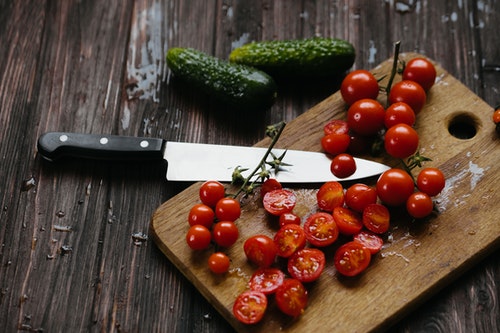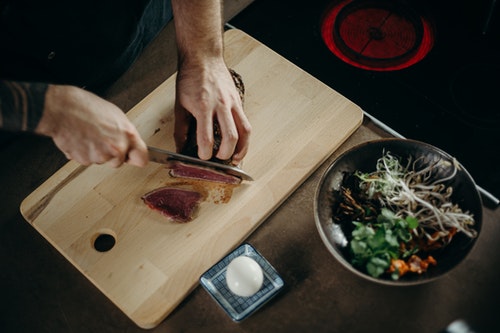There are various reasons to keep your kitchen knives sharp and in a good working condition, whether you’re attempting to keep the blades of your cooking knives keen or trying to hone your backpacker knife as it needs to be sharpened to the edge. Sharp knives are safer than dull knives; therefore, it is important to keep your cooking knives maintained to the best of your ability to ensure a safer experience. When cutting with a sharp knife, you are more like to apply less pressure and reduce the risk of injuries. Applying extra effort to a dull knife may result in distorted alignment or chipped metal of the knife’s mechanics, making it more prone to be damaged.
The sharpness of your tools is critical to the quality of your work and the safety of others in your workplace. If you want to know how to maintain your blades sharp, check out these top six suggestions.
1. Obtain a Honing Rod
Many people assume that honing rods are used to hone knives. The honing rod is utilized for alignment more than any other thing, regardless of the type of knife you’re dealing with. Your honing rod, also known as a stropping iron, is used to straighten the knife’s metal without losing considerable amounts of metal from the blade.
Techniques for Handling a Rod
There is a proper method to make the most use of the honing rod, just like there is a proper way to use any other part of knife care. Make sure to hold your cooking knife in the dominant hand while holding your honing rod in the other to get the best results from your knife. Maintain a safe distance between your fingers and the blade. Hold your knife at an angle to the honing rod defined by the angle of the blade. Across the top part of the honing rode, carefully move the knife with your full arm, sliding from the knife heel to the tip. To the bottom of your honing rod, move your knife and repeat the process after eight repeats over the top.
2. Clean Your Knives
Throwing your knives in the kitchen’s dishwasher is one of the worst things you’d do. Detergent, the barrage of water, and heat,all of them can severely harm your knife’s blade and handle. While you must sharpen your knives between usage, many people do not pay enough attention, so washing your knives properly helps to keep their edge sharp for longer.
Hand-wash your knives with a soapy dishcloth or a sponge. Make sure to keep a safe distance of your fingers from the knife’s sharp edge and always wipe from the base making it to the tip of the knife.
3. Keep Your Knives Dry
After washing your knives, immediately dry them in order to evade rusting your knife’s blade. Keeping your knives wet, particularly in some sort of a block, might result in germs and mold growing inside the storage container. While moldand germs aren’t always hazardous to the knife’s blade, they can be dangerous to the health of your family and yours as well if you keep using your knife for cooking.
4. Keep a Knife-Sharpening Tool
Whetstones, handheld diamond sharpeners, Diamond bench stones, power sharpeners, jig and clamp versions, and other tools are available in the market to re-sharpen a knife’s dull blade. The whetstone, also called a sharpening or water stone has a high learning curve. It serves anentirely different function than a sharpening rod. The majority of them have one or sometimes two sides, one rough while the other one fine. You may get whetstone in a variety of grits to help you obtain the perfect finish and shine for your knife. The smoother the whetstone’s surface, the greater the grit.

Whetstone Handling Tips
- Begin sharpening your knife on the whetstone’s rough side
- Use a rubbery shelf liner or moist cloth to keep the stone in place on your workspace.
- Place the knife on the whetstone, and keep an angle wider or equal to the width of your blade edge.
- Do you need to double-check your angle? To coat the blade edge in black, run it through a marker pen. If the angle is correct, the sharpening procedure should remove all the ink.
- Draw the blade down the whetstone with one hand placed on the handle while the other is on the middle of the flat blade.
- Make sure you move the blade in a wide circular motion at a consistent angle until you have drawn the blade multiple times along the whetstone from base to tip.
- Check the blade’s sharpness by running your thumb over the edge perpendicularly from base to tip, feeling for burrs.
- To hone the knife’s other side, flip it over to the opposite side.
- If you have a two-sided whetstone, flip it over. Continue the procedure on the fine side.
5. Storing Knife
Some knives are foldable, which makes them considerably easier to store than others. However, not all fold, so the standard knives must be stored very carefully in order to keep their edge maintained. Keep your knife apart from other kitchen utensils, hiking gear, or carpentry tools. Your unfoldable knives require something more than a drawer to safeguard their edge; they require a specialized block. You can also hang knives on a magnet rack to keep them out of the reach of children.
Whether you use a block or a hanging rack, ensure sure your knives aren’t rubbing up against one another pr other metal utensils and gadgets.
Bottom Line
When you take the time to care for your knives, you would be less likely to have complications, such as ingredients tearing when you try to slice them. Knives are an essential aspect of kitchen preparation. You want your knives in good shape, just like any other equipment you use around the house, in order to generate good outcomes. Knives will last much longer if you maintain them sharp, store them appropriately, and use them on proper surfaces.
Remember to rapidly rinse your knife with water and wipe it with a soft towel after sharpening it to eliminate any excessive metal shavings. Enjoy the newly discovered sharpness of your knife blades and observe the results of every meal you prepare.


